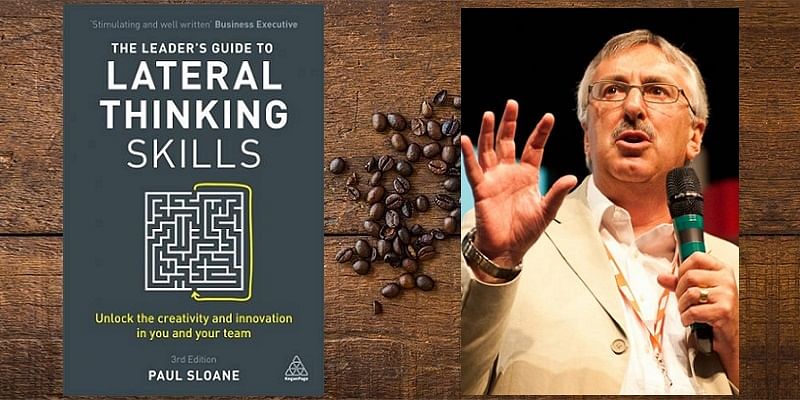Paul Sloane is the author of The Leader’s Guide to Lateral Thinking Skills: Unlock the Creativity and Innovation in You and Your Team (see my book review here). His earlier bestsellers include How to Be a Brilliant Thinker and The Innovative Leader.
A leadership and innovation consultant, he was earlier at IBM, Ashton-Tate, MathSoft, and Monactive, and today advises dozens of companies.
See also YS’s Book Review section with takeaways from over 315 titles on creativity, entrepreneurship, innovation, social enterprise, and digital transformation.
In a conversation, Paul Sloane discusses challenges in the entrepreneurial journey, the spirit of creativity, and frugal innovators.
Edited excerpts from the interview:
YS [YS]: During the COVID-19 pandemic, what are some examples you have seen of creativity and innovation in action?
Paul Sloane [PS]: I have been impressed by the way that many companies pivoted during COVID-19 and adapted to or even exploited the opportunities. Challenging times encourage innovation and fresh thinking.
There have been many fine examples of innovations during the pandemic. Here are some I came across — a hackathon in Mexico using AI to help find missing persons, high-performance supplements made from discarded food waste, and a hand stamp for kids, which disappears only when the hands are properly washed.
YS: How was your book received? What’s your next book about?
PS: The book has proved popular and is now in its third edition.
My next book is Lateral Life Skills for Everyone. We should be open-minded and receptive to new ideas, but increasingly, it seems that people are retreating into their own closed view of the world. How can we challenge people to be more open-minded and to listen to contrarian points of view?
YS: What are your findings with respect to lateral thinking in the government sector and NGOs?
PS: In my experience, government agencies tend to be risk-averse and see innovation mainly in terms of big IT projects. Charities are often innovative as they have to find creative ways to raise money.
YS: What is your current field of research or consulting in innovation?
PS: I am interested in how we can make people more open-minded and creative in their everyday lives.
I am working with pharmaceutical and healthcare companies to find ways to improve trials and other processes. I am working with finance companies to find new routes to market.
I am giving talks and workshops on leading innovation. Most of these are on Zoom or Teams, but some are now face-to-face.
YS: How should entrepreneurs retain their creative edge as they scale and also figure out when to pivot?
PS: Many entrepreneurs try to do too much themselves or they recruit people who do as they are told. They should hire the very best people they can get and then delegate more to them. They have to let go in order to grow.
Innovators and entrepreneurs have to be constant adapters – as they learn from experience, they change things. The vision should be a high-level goal and not a detailed plan.
YS: Is there such a thing as the ‘ideal age’ for innovation, or can the creative bug strike you at any time?
PS: People can start their own businesses at any age. Ray Kroc became the CEO of McDonald’s at the age of 59 and spent the next 22 years growing the company into a world leader in fast food.
YS: Who are some of the innovators you admire the most today?
PS: Elon Musk and Jeff Bezos spring to mind for their adventure, enterprise, and lateral ideas. They both think big – really big.
YS: How would frameworks of frugal innovation connect with your lateral models?
PS: I admire frugal innovation and see it as an opportunity for many businesses. I wrote a blog post about IKEA, where I describe founder Ingvar Feodor Kamprad as the master of frugal innovation.
His austere upbringing instilled a spirit of thrift. He began by selling matches as a child, and then eventually furniture. He came up with the concept of flat-pack kits that were simple and affordable for customers and less expensive for IKEA to store and transport. Customers enjoy the low prices and even the challenge of assembling the units.
YS: How should innovators deal with failures of products, and even of companies?
PS: Failure with new products is quite normal. Even with the best planning, innovative ideas can often fail for unforeseen reasons.
Companies fail too and that is part of capitalism – old or ineffective models are replaced by new ones. It is to be expected. The key thing is to learn from each failure and move on.
YS: What are the success factors for government, academia, and industry to grow innovation and entrepreneurship ecosystems?
PS:
- Investment in education – especially science and engineering.
- Making it as easy as possible to start new businesses.
- Investment in infrastructure, for example, roads, trains, and the internet.
YS: What is your parting message to the startups and aspiring entrepreneurs in our audience?
PS: Keep experimenting, keep learning, keep adapting.


![Read more about the article [Startup Bharat] This Coimbatore-based cleantech startup is building autonomous bots to clean solar panels](https://blog.digitalsevaa.com/wp-content/uploads/2021/04/Solaviofounders-1617691587571-300x150.jpg)
![Read more about the article [YS Learn] It is life after each setback and not the failure that defines you, says upGrad co-founder Ronnie S](https://blog.digitalsevaa.com/wp-content/uploads/2021/03/Image38w7-1614693547403-300x150.jpg)






